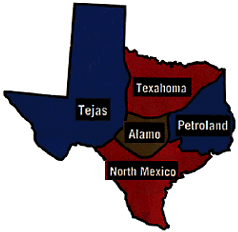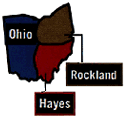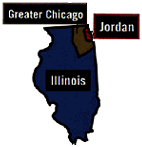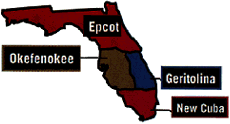|
Splitsville, U.S.A. |
 |
Here’s a quiz question for you: What American institution has used its power to thwart desegregation, campaign finance reform, health care reform, New Deal programs, gun control, and midnight basketball—and gave Adolf Hitler time to conquer most of Europe without American opposition? The answer: the United States Senate. Because of our Senate—the least representative legislative body in the democratic world except for the British House of Lords—an ever shrinking minority of voters has the power to obstruct policies favored by an overwhelming majority of the American people. The Senate is the worst branch of government, and it’s going to get even nastier in the century ahead.
If democracy means anything, it means one person, one vote—a principle flouted by the Senate’s very design, which is based on an antiquated constitutional provision that provides equal suffrage in the Senate for government units (states) rather than suffrage based on the size of a constituency. As a result, a dwindling minority of Americans elects a majority of senators.
California has 66 times as many people as Wyoming—and yet on any given vote Wyoming’s two senators can neutralize California’s two senators. Texas, with more than 19 million people, has only two senators—as many as Montana, which has less than 1 million citizens. New York, the third most populous state in the union, can be outvoted by tiny Rhode Island (the true Empire State).
This malapportionment favors inhabitants of Rocky Mountain and New England states at the expense of Americans who live in densely populated megastates—not only Sun Belt states such as California, Texas, and Florida, but also states in the Northeast and Midwest such as New York, Illinois, and Pennsylvania. True, the big states have more members in the House. But this misses the point: Why should Idahoans be represented in the House and the Senate, while Californians, Texans, and New Yorkers are effectively represented in the House alone? It’s not an even trade. The majority of Americans get nothing in return for forgoing their right to democratic representation in one-half of their national legislature.
 From the 18th century to the present, the ratio of large- to small-state populations has grown from 19-to-1 to 66-to-1. Today, half of the Senate can be elected by 15 percent of the American people—and the problem is only getting worse. Almost all of the population growth in the United States in the foreseeable future will be concentrated in a few populous states (chiefly California). By the middle of the next century, as few as 5 percent of the population, or even 1 percent, may have majority power in the Senate.
From the 18th century to the present, the ratio of large- to small-state populations has grown from 19-to-1 to 66-to-1. Today, half of the Senate can be elected by 15 percent of the American people—and the problem is only getting worse. Almost all of the population growth in the United States in the foreseeable future will be concentrated in a few populous states (chiefly California). By the middle of the next century, as few as 5 percent of the population, or even 1 percent, may have majority power in the Senate.
Even now, only 10 percent of the U.S. population elects 40 percent of the Senate. By filibustering, senators representing little more than one-tenth of the nation can block reforms supported by the House, the president—and their fellow senators, who represent the other 90 percent of the population. This is not democracy. It is minority rule. For example:
While the Senate exaggerates the power of anti-urban, anti-government conservatives in domestic policy, when it comes to foreign affairs, the Senate has always been the command post of isolationism. As late as 1940, a bipartisan team of isolationists in the Senate blocked the efforts of President Franklin Delano Roosevelt and the House to revise the country’s misguided neutrality laws and rescue Britain from defeat at the hands of the Nazis. Thanks to the unrepresentative Senate, Hitler came close to winning World War II.
 The only Americans whose views are consistently magnified by Senate malapportionment are white, rural, right-wing isolationists. If you are nonwhite or of mixed race, if you live in a major metropolitan area, if you are liberal or centrist, if you support an internationalist foreign policy, or even if you are a conservative who lives in a populous state, you should look on the Senate with loathing and apprehension.
The only Americans whose views are consistently magnified by Senate malapportionment are white, rural, right-wing isolationists. If you are nonwhite or of mixed race, if you live in a major metropolitan area, if you are liberal or centrist, if you support an internationalist foreign policy, or even if you are a conservative who lives in a populous state, you should look on the Senate with loathing and apprehension.
Because of its role in screening executive and judicial appointees, the Senate also has a disproportionate influence on all three branches. To make matters worse, the senators’ staggered six-year terms—intended to insulate the enlightened statesmen of the upper house—have merely ensured that the Senate would be out of touch with the times, as well as out of touch with the American majority.
 Original Contempt
Original Contempt
Most of the Founding Fathers hated the Senate, which they created to satisfy small states, like Rhode Island, that demanded equal representation in the new federal government. In “The Federalist No. 22,” Alexander Hamilton, criticizing the Senate by implication, identified equal representation of the states in the national government as one of the worst defects of the Articles of Confederation. Allotting representatives on the basis of statehood rather than population, he wrote, “contradicts the fundamental maxim of republican government, which requires that the sense of the majority should prevail.” Hamilton predicted that “two-thirds of the people of America could not long be persuaded, upon the credit of artificial distinction and syllogistic subtleties,” to be governed by a third of the population. “The larger States,” he concluded, “would after a while revolt from the idea of receiving the law from the smaller.” If Hamilton returned today, he’d be amazed to learn that the citizens of large states have not yet revolted against the excessive power of the statelets in America’s upper house.
In the early 1960s, the Supreme Court struck down malapportioned state legislatures as unconstitutional, arguing that they violated the principle of one person, one vote. In 1963, the Supreme Court declared in Gray v. Sanders that “the conception of political equality from the Declaration of Independence to Lincoln’s Gettysburg Address to the 15th, 17th, and 19th Amendments can mean only one thing— one person, one vote.” There you have it: The federal judiciary determined that the structural principle underlying state senates at that time—and the U.S. Senate today—was unjust and unconstitutional.
 For much of American history, white Protestant rural constituencies were deliberately overrepresented in state legislatures in order to dilute the political influence of urban dwellers, who were more likely to be European immigrants. In the 21st century, the built-in corruption of our Senate may cause a constitutional and racial crisis. Just as European immigrants in the cities were stymied by rural Anglo-Protestant “rotten boroughs” in state legislatures in the 19th century, so the coming Hispanic, black, and Asian majorities in the megastates will have their votes diluted by the overrepresentation of the white microstates in the Senate. As the Chicago lawyer and writer Tom Geoghegan has pointed out, the House will soon look like multiracial metropolitan America; the Senate will continue to look like white rural America.
For much of American history, white Protestant rural constituencies were deliberately overrepresented in state legislatures in order to dilute the political influence of urban dwellers, who were more likely to be European immigrants. In the 21st century, the built-in corruption of our Senate may cause a constitutional and racial crisis. Just as European immigrants in the cities were stymied by rural Anglo-Protestant “rotten boroughs” in state legislatures in the 19th century, so the coming Hispanic, black, and Asian majorities in the megastates will have their votes diluted by the overrepresentation of the white microstates in the Senate. As the Chicago lawyer and writer Tom Geoghegan has pointed out, the House will soon look like multiracial metropolitan America; the Senate will continue to look like white rural America.
The Senate has always functioned as the last bastion of white supremacy. The balance of slave states and free states in the Senate permitted the South to preserve slavery and weaken the federal government for a generation after its population had been surpassed by that of the North. In this century, Southern senators filibustered anti-lynching legislation, and later blocked civil rights reform. The gridlock they caused was one reason the federal courts eventually seized the initiative on desegregation. If the emergent multiracial majority in the United States perceives the Senate as the tool of selfish white obstructionists, pressure will grow on the judiciary or the president to take control and push through reforms that the majority needs and approves—at the cost of further weakening our constitutional order.
 Divide and Rule
Divide and Rule
Can anything be done about the Senate and its weighted vote for white reactionaries? A distinguished New York senator once grumbled to me over dinner, “You should write an article saying we should combine all those Western states into one.” Alas, we can forget about creating a single populous “state of Deseret” by forcibly consolidating all those states with right-angle corners. The microstate delegations to the Constitutional Convention of 1787 managed to booby-trap the Constitution to protect themselves. Article V states that the American people cannot amend the Constitution to get rid of equal suffrage for the states: “No State, without its Consent, shall be deprived of its equal suffrage in the Senate.” And Article IV, Section 3, provides that no state can “be formed by the Junction of two or more States, or parts of States, without the consent of the Legislatures of the States concerned as well as of the Congress.” Not one, but two poison pill provisions.
Yet there is a way to address the problem of Senate malapportionment, one that doesn’t require us to abandon the Constitution or to alter the two-senators-per-state rule. Let’s go back and read Article IV, Section 3, in its entirety:
New States may be admitted by the Congress into this Union; but no new State shall be formed or erected within the Jurisdiction of any other State; nor any State be formed by the Junction of two or more States, or Parts of States, without the Consent of the Legislatures of the States concerned as well as of the Congress.
Why not form new states within the jurisdictions of the existing megastates? Why not divide in order to rule? This is not as crazy as it sounds. Commentator Walter Russell Mead has suggested that no American should have to live in a state with more than 4 or 5 million citizens. If the 4-million-population rule were applied to the large states, California might be subdivided into eight new states; Texas, five; New York and Florida, four; Pennsylvania, Illinois, and Ohio, three; and Michigan and New Jersey, two.
 Eight Californias? Five Texases? Four New Yorks? Why not?
Eight Californias? Five Texases? Four New Yorks? Why not?
With 25 new states in the union, the Senate would be far more representative of the American people. The citizens of the nine largest states, who today send a mere 18 senators to Washington, would soon have a total of 68 senators to defend their interests against senators from microstates like Vermont and Wyoming. The overall Senate representation of the voters in present-day California, Texas, and New York alone would jump from 6 to 34. The House functions with 435 representatives; a Senate with 150 members would be quite manageable.
This scheme would be perfectly constitutional under Article IV—as long as the small states as well as the populous states consented. Obviously the megastates would have to strike a deal with the microstates, so that they did not then subdivide into still tinier units (nanostates?). Under this proposal, states like Wyoming would still have roughly four times greater representation in the Senate than California’s eight new states of 4 or 5 million citizens apiece—and would have reason to be grateful that California didn’t divide into 32 new states.
How could the microstate politicians be persuaded to go along with the dilution of their unjust authority in the Senate? Perhaps the megastate majority in both parties would give the microstate senators no choice. The moment the Senate’s malapportionment becomes a popular political issue, both parties are likely to sacrifice the wishes of their Rocky Mountain and New England minorities in order not to offend the megastate voters who will decide which party controls the House and the presidency.
 Lose a State, Gain a Caucus
Lose a State, Gain a Caucus
In 1997, British conservatives paid the price for ignoring an equally vexing problem of constitutional reform. The Conservative Party was decimated when voters in Scotland and Wales flocked to the Labor-Liberal Democrat alliance that promised local legislatures for the two regions. In this country, the direct election of U.S. senators was proposed in minor-party platforms as early as 1876; it became part of the Democratic Party platform in 1900; and it was not achieved until the 17th Amendment passed in 1913. This proves that, even in the United States, once a national majority is aroused, the Senate can be reformed—eventually (for 20 years, the Senate did not even let the amendment come to a vote, even though the House had approved it five times).
Selling subdivision to residents of Florida, New York, California, and other populous states should be much easier. (I am referring to legal and consensual division, of course, not to militiamen declaring that a ranch is a republic.) The states of the American union do not correspond to real geographic, social, or economic groups—and never have. Most of the state boundaries were drawn by surveyors, with little or no regard to the actual contours of the landscape. The map of the American states is like a section of wire mesh pressed down atop an abstract expressionist painting. The high mobility among Americans, coupled with the present high level of foreign immigration, renders state patriotism tenuous. Indeed, the voluntary division of some states would delight many of their inhabitants. In the 1960s there was a proposal to make New York City a state. In 1992, voters in a majority of California counties voted in favor of splitting California in two. Citizens of adjacent counties in Kansas, Colorado, Oklahoma, Nebraska, and Texas recently sought to form a new state, West Kansas. In Texas, it would be sad to see the Lone Star flag lowered for the final time. But though the state song calls Texas an “empire wide and glorious,” Texas is not an arbitrary political unit, but a distinctive cultural region, like New England or the Pacific Northwest. Lose a state, gain a caucus.
Conservatives and populists who today denounce the centralized rule of the statehouses in Sacramento or Albany or Austin should be delighted with the idea of two dozen smaller states, whose legislatures would be more responsive to their smaller, more manageable constituencies. Liberals, too, should be pleased—voting power would shift away from almost exclusively white hinterland electorates toward urban, Hispanic, black, and immigrant voters. Libertarians could celebrate the choice of lifestyles offered by the states of Orange and Marin. And neo-Progressives who want to eliminate redundant levels of government might at last get their wish—at least in unitary city-states like those based on New York City, Los Angeles, and Philadelphia. Provision might be made for any state, once its population reaches 8 or 10 million, to split into two new states of 4 or 5 million citizens. Depending on the growth of the U.S. population and its density, the number of stars on the American flag might rise from 50 to 75 to 100.
 Short of scrapping the Constitution altogether, the voluntary division of the big states into new, smaller states is the only way that the citizens of megastates can end their semicolonial subjugation to an electoral minority in the microstates. It may also be the only way to avoid a race war between the two houses of the U.S. Congress in the 21st century, when the real “white house” will be the Senate. If the majority cannot rule by constitutional means because of the Senate, then it will rule by extraconstitutional measures, through an imperial presidency or an imperial judiciary. We can use the Constitution to reform the Senate—or trash the Constitution to get around the Senate. The choice is ours.
Short of scrapping the Constitution altogether, the voluntary division of the big states into new, smaller states is the only way that the citizens of megastates can end their semicolonial subjugation to an electoral minority in the microstates. It may also be the only way to avoid a race war between the two houses of the U.S. Congress in the 21st century, when the real “white house” will be the Senate. If the majority cannot rule by constitutional means because of the Senate, then it will rule by extraconstitutional measures, through an imperial presidency or an imperial judiciary. We can use the Constitution to reform the Senate—or trash the Constitution to get around the Senate. The choice is ours.
Michael Lind is the author of The Next American Nation. This article is first in a four-part series on democratic political reform. Forthcoming articles will look at new alternatives to our campaign finance and electoral systems.















